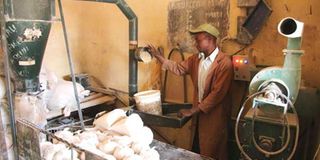Proper planning vital as more maize imports will be required

A man milling maize flour in a posho mill. We will have to import more maize this year. It will not be in the quantities of last year and will be needed around the second quarter of the year. FILE PHOTO | NATION MEDIA GROUP
What you need to know:
Farmers in the North Rift region naturally want a good price for their produce.
The government is committed to ensuring the availability of affordable maize to the population.
When it comes to the spectre of imports, there is a history of leaving everything late and responding in a reactive knee-jerking manner.
We will have to import more maize this year. It will not be in the quantities of last year and will be needed around the second quarter of the year.
The subject of maize and imports is often an emotive one. It is a major staple food for the majority of Kenyans and for many of our livestock, and understandably, has a special place in our national agricultural priority list.
However, it is often the subject, or victim, of colliding interests.
Of course, the farmers in the North Rift region naturally want a good price for their produce and at the same time, the government is committed to ensuring the availability of affordable maize to the population.
SUBSIDY SCHEME
Such was the paranoia about the rising price of maize last year that the government was forced to introduce a subsidy scheme. But many also saw this as political opportunism in the run-up to the August 8 elections.
In a good year, the country can be self-sufficient in maize maybe with a little bit of help coming from our neighbours Uganda and Tanzania. But often whenever there is a projected shortfall of the commodity the government bends over backwards to play this down, as if it has been offended at the very suggestion.
Last year, outgoing Agriculture, Livestock and Fisheries Cabinet Secretary Willy Bett several times denied the country would need maize imports this year, and, in turn, blamed the usual bogeymen for hoarding: The millers and traders.
What then is the overall picture? The country consumes nearly 4 million tonnes of maize and 1.5 million tonnes of wheat a year.
CONSUMPTION
Due to the prolonged drought and an invasion of army worms on the farms in the North Rift last year, the annual maize harvest dropped to between 2.5 to 2.8 million tonnes, so well below consumption.
If one factors in the strategic reserve and the informal imports from Tanzania and Uganda, Kenya has enough maize for the next three months.
That said, it is worth adding that as the domestic supplies tighten up, the retail price of maize is likely to increase. We could see upward pressure on the price as early as March, and especially in April. The new Agriculture and Supplies Cabinet secretary, Mr Mwangi Kiunjuri, should now get a full grasp of the food position as soon as possible. And this means meeting with and listening to the industry stakeholders as well as getting input from officials in his own ministry.
OPTIONS
Once done, the CS can then consider the range of options and have them put in place in a proactive manner.
When it comes to the spectre of imports, there is a history of leaving everything late and responding in a reactive knee-jerking manner.
One of the first things the minister should ensure is that the flow of maize coming from neighbouring countries is facilitated and not impeded, especially at the border crossings.
Another is to carefully calculate the likely shortfall and put in place a transparent tender to obtain the required maize from abroad. The process for this should kick in next month, especially as it has budgetary implications.
BEST PRICE
This would help ensure that we get the best price possible in the prevailing world market and receive supplies in a timely fashion.
That is a very important consideration this time around, as on average, the world prices for white maize are around 20 per cent higher, which will translate into higher domestic retail prices.
In conjunction with this should come the suspension of import tariffs on maize for a specific period to ensure the needed imports arrive at the best price possible.
Mr Shaw is a public policy and economic analyst:[email protected]





